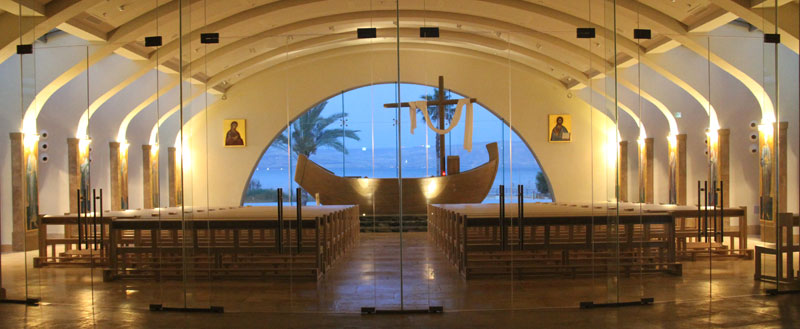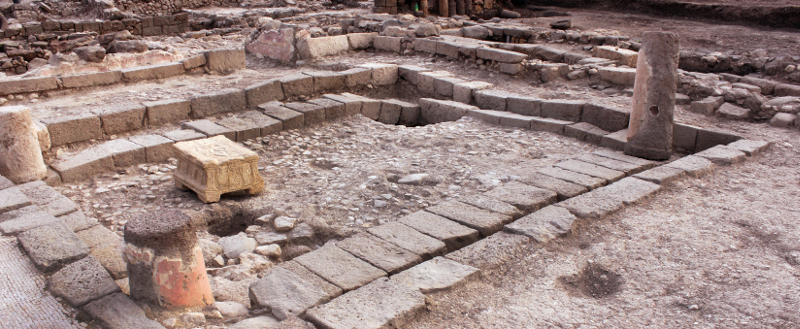Follow in the Footsteps of Jesus and Mary Magdalene to Magdala

Of the many sites in Israel available to pilgrims looking to immerse themselves in environments that recall the people, places, and events of the Bible, Magdala is one of the newest to open.

The modern city of Migdal was only recently founded, in 1910. In biblical times it was known as Magdala, the home and birthplace of Mary Magdalene. Magdala fell in 67 CE after a siege by Roman forces; the archaeological remains of the settlement were only re-discovered in 2009 when a routine dig prior to the construction of a new retreat center uncovered a first century synagogue. There are only a few synagogues in all of Israel that have been excavated from the first century. Given its date and location, it is likely Jesus preached here. Matthew’s Gospel states: Jesus went throughout Galilee, teaching in their synagogues, preaching the good news of the kingdom, and healing every disease and sickness among the people. (Matthew 4:23 – NIV) It is probable that Mary Magdalene would have prayed here as well.
What to See in Magdala
Visitors to Magdala can currently explore the archaeological site and the recently constructed spiritual center, Duc In Altum, which contains several chapels and an atrium dedicated to the women of the Bible. Construction is underway on a visitor center, a 160-room guesthouse, a restaurant, and a seaside worship center, while excavations continue at the archaeological park.
Duc in Altum
Duc In Altum derives its name from Luke 5:4, in which Jesus tells Simon Peter to “launch into the deep.” The Women’s Atrium honors women of the Bible and contains eight pillars, seven of which represent specific women from the Bible, and one that represents women of faith across time. The pillars honor Mary Magdalene; Susana and Joanna, the wife of Chuza; Mary and her sister Martha; Salome, the mother of James and John; Simon Peter’s mother-in-law, who was healed by Jesus; Mary, wife of Cleopas; and the many other women from the Bible who supported Jesus.
The Boat Chapel features an altar in the shape of a boat in front of a large window overlooking the Sea of Galilee. It recalls when Jesus stepped into Simon Peter’s boat and preached to a crowd from the Sea of Galilee.
In addition to the Boat Chapel, Duc In Altum contains four smaller Mosaic Chapels, each of which features a beautiful mosaic depicting a biblical event that occurred on or near the Sea of Galilee.
Finally, the Encounter Chapel, housed in the lower level of Duc In Altum, features a large painting entitled “Encounter.” The painting depicts the biblical story of the hemorrhaging woman who attempts to touch Jesus in hopes of being healed (Mark 5: 25-29) and is meant to represent Jesus’ encounter of all of us. The chapel’s structure is inspired by the Magdala First Century Synagogue, while its floor dates back to the first century and is the site of the marketplace where many fishermen from the Sea of Galilee would have come to sell their fish. Here it is easy imagine Jesus encountering various people in the marketplace, including fisherman, merchants, traders, and locals.

image courtesy of www.magdala.org
Archaeological Park
Excavations at the Magdala archaeological park began in 2009 upon the discovery of the first century synagogue. Although there is much left to be excavated, there are several finds at Magdala that will be of interest to visitors and pilgrims.
The synagogue at Magdala is one of seven first century synagogues throughout Israel. Archaeologists found a coin here that was minted in Tiberias in 29 CE—coinciding with the time of Christ’s ministry. Jesus would have stopped to preach during his travels throughout Galilee and Mary Magdalene would have prayed here.
The Magdala Stone is a recent find that archaeologists are hoping will increase our understanding of Judaism in the first century. It is the oldest known artistic representation of the Second Temple, which stood upon the Temple Mount for six centuries until it was destroyed by the Romans in 70 CE. Archaeologists are still trying to interpret the decorative symbols covering the stone that depict not only the Temple structure, but also various ceremonial Jewish objects. More detailed information on the stone—including photographs from various angles—is available at www.magdala.org.
In addition to the synagogue and the Magdala Stone, visitors to Magdala can marvel at the remains of several ancient mansions paved with colorful mosaic floors; ritual baths, or mikvaot; a marketplace with a technologically advanced and still-functioning plumbing system for fresh groundwater; and a warehouse and wharf. For more detailed information, visit www.magdala.org

image courtesy of www.magdala.org
Magdala Visitor Information
Magdala is open to visitors every day (Monday-Sunday) from 8:00am to 6:00pm. Clergy, pastors, and tour leaders can get in free and discounts are offered to both seniors and students.
Illume takes pride in creating experiences that broaden perspective, explore other cultures, deepen faith and create bridges of understanding between people of all cultures and walks of life. Following in the footsteps of Jesus to sites like Magdala can be transformative for believers and non-believers alike, who may be inspired by visionary men and women from the past, their fellow sojourners, and those they meet overseas who practice their faith and conduct their lives in a variety of different ways.
Contact Illume today to arrange a travel program to Israel for your congregation, interfaith group, or other constituency.
